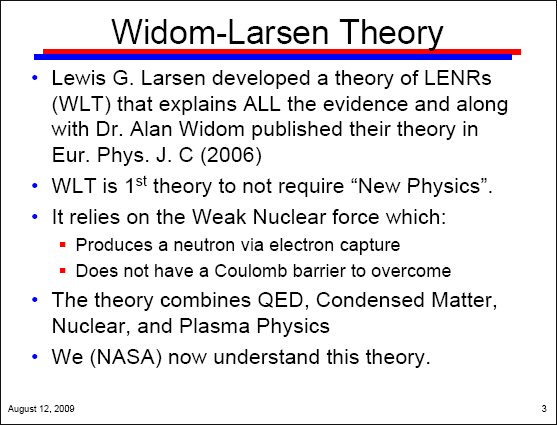Several years ago, NASA scientists identified one theory that appears
to explain low-energy nuclear reactions. Since then, in their public
communications, they have given credit to the inventor of the theory.
Not anymore.
After filing a patent application in 2011 based on this theory, one of these scientists, in his public communications, stopped giving credit to the inventor.
On March 9, 2006, Allan Widom, a condensed matter physicist with Northeastern University, and Lewis Larsen, chief executive officer of Lattice Energy LLC, published a landmark theory that offers a promising explanation for low-energy nuclear reactions.
Two scientists at NASA’s Langley Research Center, Dennis Bushnell and Joseph Zawodny, saw the promise of the Widom-Larsen ultra-low-momentum neutron theory of LENRs.
For several years, Bushnell and Zawodny spoke favorably and enthusiastically about the Widom-Larsen theory as well as LENR in general.
Thursday, Larsen told New Energy Times that he spoke with both NASA employees by phone to help them learn about LENR and his theory.
“I spent six months tutoring Zawodny so he had the basics of the theory,” Larsen said.
Larsen told New Energy Times that Bushnell and Zawodny also led him to believe that NASA might provide some funding for his company.
“In a series of telephone calls I had during the spring and summer of 2008 with Zawodny and Bushnell, they dangled a carrot - the possibly of significant funding from NASA,” Larsen said. “I told them that I was wiling to teach them the basic physics but I would not transfer Lattice’s proprietary knowledge about how to use nanotechnology to improve the reliability of LENRs without having a contract.
“I told them, ‘Under contract, I will show you how to make transmutations every time, but I will not show you how to reliably make large amounts of heat.’
“In January 2009, after an internal NASA meeting, Bushnell and Zawodny informed Lattice that they would not be funding us but they would welcome any free advice we wanted to offer NASA. We declined.”
On Aug. 12, 2009, Zawodny gave a slide presentation on LENRs called “An Energetics Revolution for ALL of NASA’s Missions and a Solution to Climate Change and the Economic Meltdown.”
Several of the slides are devoted to the Widom-Larsen theory. Slide No. 2 shows that Zawodny knew that only one theory in the field of LENRs did not attempt to make charged particles overcome the Coulomb barrier at room temperature. Slide No. 3, as shown below, indicates that Zawodny also knew that the Widom-Larsen theory was the first theory of LENRs that did not require “new physics.”

I, too, have learned a lot from Larsen. Last year, as a result, Zawodny and I combined our efforts and contributed a chapter on the Widom-Larsen theory to the Wiley Nuclear Energy Encyclopedia.
On Feb. 22, 2011, Larsen was granted U.S. patent 7,893,414 for an invention based on his theory, which, at its core, describes a novel method for producing heavy electrons.
A month later, on March 24, Zawodny filed his non-provisional U.S. patent application 20110255645 for a “Method for Producing Heavy Electrons.”
Naturally, Zawodny had to cite the Larsen patent as well as the Widom-Larsen theory.
“The energy associated with ‘low energy nuclear reactions’ (LENR) has been linked to the production of heavy electrons,” the Zawodny application states. “Briefly, this theory put forth by Widom and Larsen states that the initiation of LENR activity is due to the coupling of ‘surface plasmon polaritons’ (SPPs) to a proton or deuteron resonance in the lattice of a metal hydride.”
On Sept. 22, 2011, Zawodny gave a slide presentation about LENR at NASA’s Glenn Research Center. His second slide asks, “Do we have a theory?” He mentions a theory by inventor Randall Mills and dismisses it. He mentions a theory by Purdue professor Yeong Kim and dismisses it, too. He then presents several slides that speak very encouragingly about the Widom-Larsen theory and why it “may be correct.”
The Zawodny patent application published on Oct. 20, 2011.
Four days later, on Oct. 24, 2011, Aviation Week published an article about LENR written by Zawodny.
“Theories to explain the phenomenon have emerged,” Zawodny wrote, “but the majority have relied on flawed or new physics.
Not only did he fail to mention the Widom-Larsen theory, but he wrote that “a proven theory for the physics of LENR is required before the engineering of power systems can continue.”
On Jan. 12, 2012, NASA released a short promotional video titled “Method for Enhancement of Surface Plasmon Polaritons to Initiate and Sustain LENR.” At the end of the video, the narrator restates the title as “NASA’s Method for Enhancement of Surface Plasmon Polaritons to Initiate and Sustain LENR in Metal Hydride Systems.”
Zawodny is prominently featured. He mentions nothing of the Widom-Larsen theory or Larsen’s concept of how surface plasmon polaritons are a primary key to initiate LENRs.
I sent Zawodny an e-mail on Thursday and asked for an explanation of the omission.
“The intended audience is not interested in that level of detail,” Zawodny wrote. “The text I am intending to send you, after approval, clarifies things, hopefully.”
Readers may learn more about the Widom-Larsen theory from their paper published in the peer-reviewed journal Pramana.
[Update and Correction: After reading this article, Zawodny sent me an e-mail on Jan. 13, 2012 with only one correction: "You should be informed that a provisional patent [application] was filed almost exactly one year earlier. At the time the non-provisional was filed, Larsen’s gamma shielding patent had to be cited as a relevant related patent.”
For additional clarification, Larsen filed his international patent application on Sept. 8, 2006. That published on March 15, 2007.
Zawodny filed his a provisional U.S. patent application in March 2010. He filed his non-provisional patent application on March 24, 2011. We have corrected the article to reflect this fact. ]
|

